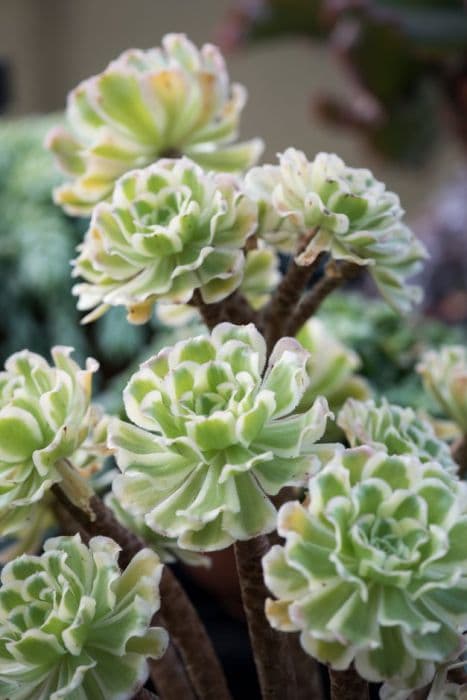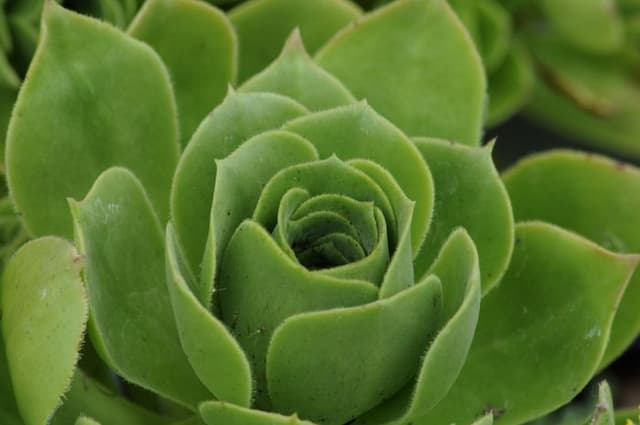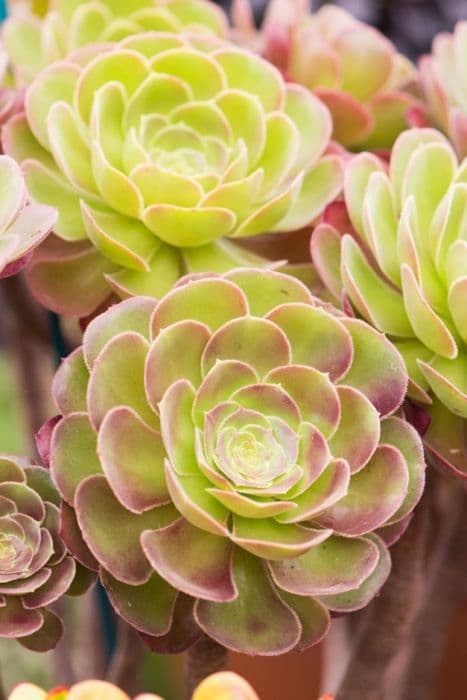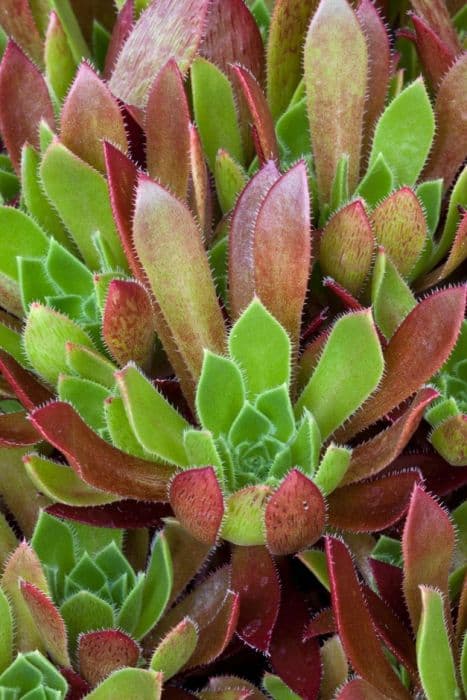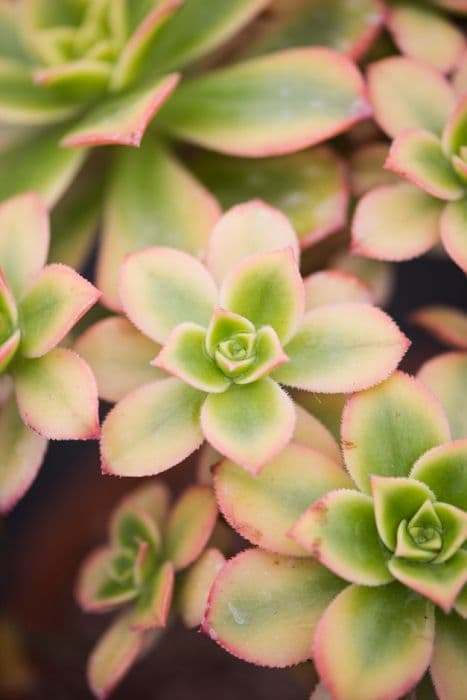Purple Stonecrop Sedum spathulifolium 'Purpureum'











ABOUT
Sedum spathulifolium 'Purpureum', commonly known as Purple Stonecrop, is a low-growing, evergreen perennial with a distinctive appearance. This succulent forms rosettes of thick, spoon-shaped leaves that are initially a powdery blue-green color. As the name 'Purpureum' suggests, the foliage has a remarkable purple hue, especially under stress conditions such as cold or drought. The leaves of the Purple Stonecrop are fleshy with a waxy coating, which is typical of many succulents as it helps retain moisture. Throughout different seasons or fluctuating temperatures, the intensity of the purple coloring can vary, adding visual interest to the plant. The leaf edges may also show hints of a deeper red or magenta. During its blooming period, Purple Stonecrop produces clusters of small, star-shaped flowers. These blooms stand out in contrast to the foliage with their bright yellow color, attracting pollinators such as bees and butterflies. The flowering stems rise just above the foliage, presenting the blooms in a way that they seem to float above the leaf rosettes. The overall form of the Purple Stonecrop is mat-forming, with the rosettes clustering together, creating a carpet-like effect over the ground or in rock gardens where it is commonly used. This trait makes it an excellent choice for ground cover purposes, edging, or for adding texture and color to container plantings. The combination of its striking leaf color, captivating blooms, and dense growing habit make Sedum spathulifolium 'Purpureum' a visually appealing and versatile plant for a variety of garden settings.
About this plant
 Names
NamesFamily
Crassulaceae
Synonyms
Cape Blanco Stonecrop, Broadleaf Stonecrop, Pacific Stonecrop, Purple Spoon-Leaved Stonecrop
Common names
Sedum spathulifolium 'Purpureum'.
 Toxicity
ToxicityTo humans
Broadleaf stonecrop generally is considered non-toxic to humans. There are no significant toxic effects reported for ingestion of this plant. However, as with any plant material, individuals may have allergies or sensitivities that could cause mild discomfort or gastrointestinal upset if ingested.
To pets
Broadleaf stonecrop is also generally considered non-toxic to pets. It is not known to cause serious illness or fatalities in pets if ingested. Though it is not toxic, pets may still experience mild gastrointestinal upset if they eat large quantities of the plant. It's always best to discourage pets from eating plants to avoid potential digestive issues.
 Characteristics
CharacteristicsLife cycle
Perennials
Foliage type
Evergreen
Color of leaves
Grey-green
Flower color
Yellow
Height
0-10 inches (25 cm)
Spread
0-24 inches (61 cm)
Plant type
Succulent
Hardiness zones
5
Native area
North America
Benefits
 General Benefits
General Benefits- Low Maintenance: Sedum spathulifolium 'Purpureum', commonly known as Purple Spoon-Leaved Stonecrop, requires minimal care once established, making it ideal for busy gardeners or those new to gardening.
- Drought Tolerant: The succulent leaves store water, allowing the plant to thrive even in dry conditions or during water restrictions.
- Attracts Pollinators: The flowers of the Purple Spoon-Leaved Stonecrop are attractive to bees, butterflies, and other beneficial insects, supporting biodiversity.
- Ground Cover: Its spreading habit creates a dense mat, which can help reduce weed growth and cover bare spots in the garden.
- Visual Interest: The purple-tinged foliage and bright yellow flowers add contrasting color and texture to rock gardens, borders, and container plantings.
- Cold Hardy: It is able to withstand cold temperatures and can be grown in many climates, making it a versatile choice for different gardens.
- Easy to Propagate: This plant can be easily propagated through cuttings or division, providing an economical way to expand your garden or share with friends.
- Erosion Control: Its mat-forming characteristic can help stabilize slopes and areas prone to erosion.
 Medical Properties
Medical PropertiesThis plant is not used for medical purposes.
 Air-purifying Qualities
Air-purifying QualitiesThis plant is not specifically known for air purifying qualities.
 Other Uses
Other Uses- Photography Accent: The Sedum spathulifolium 'Purpureum', commonly known as the Purple Stonecrop, can provide a unique, colorful background or an intriguing foreground subject for photographers, especially macro photography enthusiasts.
- Fairy Gardens: Purple Stonecrop is an excellent addition to fairy gardens due to its miniature, low-growing habit and can simulate larger landscape features in these whimsical settings.
- Green Roofs: Purple Stonecrop's hardiness and drought resistance make it a suitable choice for planting on green roofs, where it adds a pop of color and thrives with minimal maintenance.
- Cold Frame Gardening: As a cold-tolerant succulent, Purple Stonecrop can be used in cold frames to extend the gardening season and add interest during the cooler months.
- Art Installations: Because of its distinctive color and form, Purple Stonecrop can be incorporated into living art installations, either as the main feature or as a contrasting detail.
- Edging in Xeriscaping: The plant can be used for edging paths or defining areas in xeriscaped gardens, helping to create a structured yet water-efficient landscape.
- Landscape Color Themed Areas: Purple Stonecrop can be used to create monochromatic garden sections or to complement other purple hued plants for a cohesive visual flow in the landscape.
- Moss Alternative: In dry, sunny spots where moss struggles, Purple Stonecrop can be an effective alternative groundcover, offering a similar textural appeal.
- Living Wreaths: The dense, mat-forming nature of Purple Stonecrop allows it to be easily used in creating living wreaths that change colors with the seasons.
- Terrarium Accents: The small size and interesting texture of Purple Stonecrop make it a perfect addition to succulent terrariums, adding height and a burst of purple amidst other green plants.
Interesting Facts
 Feng Shui
Feng ShuiThe Stonecrop is not used in Feng Shui practice.
 Zodiac Sign Compitability
Zodiac Sign CompitabilityThe Stonecrop is not used in astrology practice.
 Plant Symbolism
Plant Symbolism- Resilience: The 'Purpureum' variety of Sedum spathulifolium, commonly known as the Purple Stonecrop, represents resilience due to its ability to withstand drought and poor soil conditions.
- Adaptability: Symbolizing adaptability, the Purple Stonecrop can thrive in various environments, much like its succulent relatives which adjust to different growing conditions easily.
- Peace: The soft, muted purple hues of the leaves can evoke a sense of calm and peace, often used in gardens as a tranquil accent.
- Longevity: Given its perennial nature, the Purple Stonecrop can symbolize longevity and the ability to stand the test of time.
- Survival: This plant is often associated with survival because of its hardy characteristics and ability to live where other plants cannot.
 Water
WaterThe Broadleaf Stonecrop requires minimal watering and thrives in well-draining soil. It should be watered when the top inch of soil feels dry to the touch, which typically amounts to about once a week during the growing season. In the winter, reduce watering to every other week or less, as the plant is dormant and uses less water. When watering, give the plant a thorough soaking so that water reaches the root zone, using approximately 0.5 gallons per square foot of soil area, depending on pot or garden bed size. Avoid waterlogging as this can lead to root rot in succulents like the Broadleaf Stonecrop.
 Light
LightThe Broadleaf Stonecrop prefers full sun to partial shade. It thrives with at least six hours of direct sunlight daily, but it can also tolerate some shade, especially during the hottest part of the day. The ideal spot for this sedum is where it can bask in the morning sun while being protected from the intense afternoon rays, making an east or west-facing location suitable for its growth.
 Temperature
TemperatureBroadleaf Stonecrop is cold-hardy and can tolerate temperatures as low as 20°F but performs best in temperatures between 60°F and 75°F. It is capable of surviving in temperatures up to around 90°F. The plant is well-suited for growing in USDA hardiness zones 5 to 10, where these temperature conditions are typically found.
 Pruning
PruningPruning the Broadleaf Stonecrop helps shape the plant and remove any dead or damaged foliage. It's best to prune in early spring, just before new growth starts, cutting back up to one-third of the plant to stimulate healthy, compact growth. Pruning can be done annually or as needed if the plant appears overgrown or unkempt. Use clean, sharp scissors or pruning shears to make precise cuts without damaging the succulent leaves.
 Cleaning
CleaningAs needed
 Soil
SoilFor the Broadleaf Stonecrop, a well-draining soil mix is ideal with equal parts of potting soil, coarse sand, and peat or coir to promote aeration. The perfect soil pH should be slightly acidic to neutral, ranging from 6.0 to 7.5.
 Repotting
RepottingBroadleaf Stonecrop should be repotted every 2-3 years or when it outgrows its container. This routine helps to refresh the soil and provide space for growing roots.
 Humidity & Misting
Humidity & MistingBroadleaf Stonecrop prefers low to moderate humidity levels since it is a succulent plant adapted to drier conditions.
 Suitable locations
Suitable locationsIndoor
Place Broadleaf Stonecrop in bright light, away from drafts.
Outdoor
Plant in full sun or partial shade in well-draining soil.
Hardiness zone
5-9 USDA
 Life cycle
Life cycleSedum spathulifolium 'Purpureum', commonly known as Broadleaf Stonecrop, begins life as a seed that germinates in spring to early summer. The seedlings grow into rosettes, which are capable of photosynthesis and start to establish a root system. As the plant matures, it develops fleshy, purple-tinged leaves that are adept at storing water, allowing it to thrive in rocky, well-draining soils. During the summer, Broadleaf Stonecrop produces clusters of star-shaped yellow flowers atop tall, slender stems, attracting pollinators and potentially setting seed for the next generation. After flowering, the plant may enter a dormant phase, particularly in colder climates, where it conserves energy and resources through the winter. Over time, this succulent can spread to form mats or clusters of rosettes by producing offsets, which contribute to its perennial growth habit.
 Propogation
PropogationPropogation time
Spring to Summer
Sedum spathulifolium 'Purpureum', commonly known as Broadleaf Stonecrop, is commonly propagated by leaf cuttings, which is an easy and effective way to grow new plants. During the active growing season, typically spring through early fall, select healthy leaves from an established plant. Gently twist the leaf from the stem, taking care to include a small piece of the stem if possible, which can increase the chances of successful rooting. Lay the leaf on top of a well-draining soil mix designed for succulents, and place it in a warm area with bright, indirect light. In a few weeks, the leaf will develop roots and possibly new growth at the base. Once a substantial root system has formed, you can pot the new plant into a container with succulent soil mix. It's important to avoid overwatering during this period; the soil should be kept slightly moist but not soggy.
